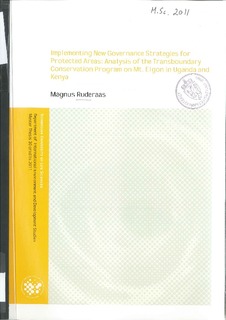| dc.description.abstract | This thesis aim to examine the process of how a transboundary protected area
management strategy (TBPAM) is introduced and implemented, using the case of Mt.
Elgon in Kenya and Uganda. TBPAM has received much attention over the last years
and have been widely promoted, especially in Southern Africa. The program on
Elgon, called Mount Elgon Reginal Ecosystem Conservation Program (MERECP) is
the first attempt to implement such strategy in the region, and is therefore regarded as
a pioneer program in East Africa.
Data was obtained through questionnaires and interviews with key stakeholders in the
MERECP program. Questions were focused on mapping the stakeholders role in
MERECP, understanding of transboundary issues and how the transboundary strategy
matched the challenges facing protected area governance on Mt. Elgon. Moreover
secondary data like MERECP reports and reviews are used as a data source. The
thesis is rooted in institutional theory, and applies the analytical tools of stakeholder
analysis and social network analysis to analyze the data obtained.
The MERECP project was introduced to Mt. Elgon by IUCN and gained the support
of the Governments of Kenya and Uganda, and donors Norway and Sweden.
Currently there are six different protected areas on Mt. Elgon, managed by five
different organizations that all apply different conservation strategies. Bringing these
organizations together and harmonizing their conservation strategies have proved
difficult. The major reason for this is that there is a big difference among the actors
involved in regards to their capacity, both in terms of financial and academic
resources, furthermore many of the stakeholders involved perceive the solution to
challenges faced by the protected areas to be of a national origin than a national.
There are also few results so far that can be characterized as “transboundary” and
these results mainly involve only the stakeholders with the highest capacity.
This paper raises questions as to the applicability of TBPAM on Elgon, and argue that
the top-down manner in which the program was introduced have resulted in a program with while promoting transboundary cooperation, is not the best fit to
address problems faced by protected area governance on Mt. Elgon. | no_NO |
